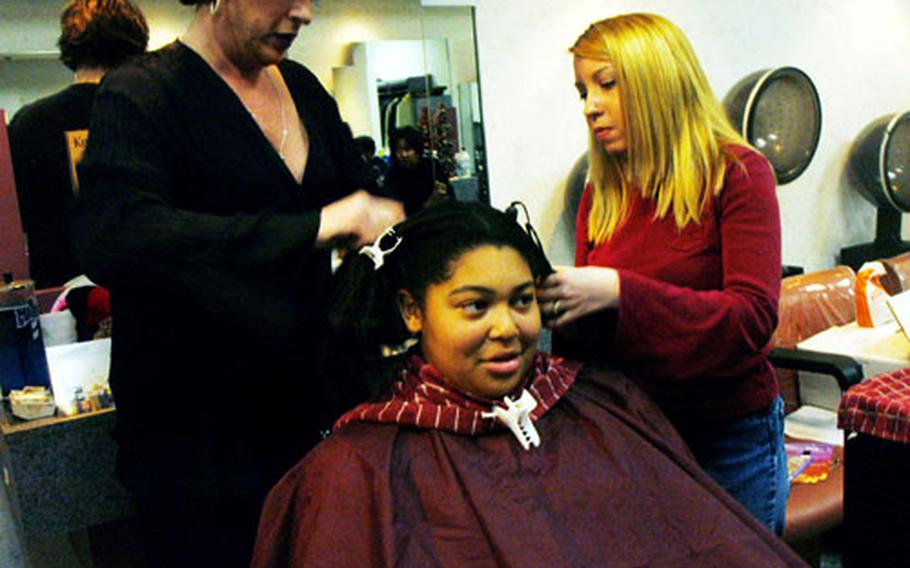
Navy Exchange hair stylists Lisa Haddock and Tressa Horner practice ethnic hair treatment on Christian Garner Tuesday in a hands-on course designed to trim waiting lists for multicultural hair care on Japan's Navy bases. (Allison Batdorff / Stars and Stripes)
YOKOSUKA NAVAL BASE, Japan — A trip to the beauty shop might involve color, but it should be tints and shades, not divisions of “black hair” and “white hair,” said stylist Linda Berrien.
But that dividing line often is there for stylists and clients alike — even in the multicultural military, she said.
“Black people like to go to black hairstylists. White people like to go to white stylists,” Berrien said Tuesday. “People are people everywhere, and we all want a good haircut — which means the hair stays on the head and not in the drain.”
But what if you’re overseas?
Lisa McCloud, who’s black, tried to get her hair done off-base in Japan.
The Navy spouse’s verdict?
“Let’s just say it wasn’t good. That’s why I’m here,” McCloud said.
“Here” was Yokosuka Naval Base’s Navy Exchange salon, where in the past clients could get ethnic hair care but had to contend with long waiting lists. Ethnic clients wanted only certain stylists, creating a backlog, said salon supervisor Rachel Possert.
So the Navy Exchange and models like McCloud put their heads together to give stylists more hands-on ethnic hair experience. Their main goal was to shear the waiting list by giving all 10 stylists a course in chemistry and ethnic hairdos.
Berrien, a hair designer and educator for Avlon Industries, taught the class, saying the modern stylist needs to serve all customers comfortably. A wider set of skills benefits the clients’ convenience factor and pads stylists’ pocketbooks by making them more flexible, she said.
“In this multicultural world, you have to be able to do it all,” Berrien said. “Hair isn’t really about ethnicity — it’s about texture and type. I have black clients that don’t need straightener and Jewish and Hispanic clients that do. We need to sweep that old thinking under the rug.”
Her seminar included physical and chemical hair structure, pH scale and hair conditioning. Models were brought in so stylists could practice and analyze how they did.
Yokosuka is just the first stop on Berrien’s tresses tour. The Navy Exchange also has hired her to train in NEX salons at Naval Air Facility Atsugi, Sasebo Naval Base and Guam before the end of the month.
Tressa Horner, a white stylist, learned how to do ethnic treatments in beauty school, but Tuesday was the first time she did a relaxer — a chemical process in which the hair is straightened — on a person, not a mannequin.
“I love it,” Horner said. “The only reason I wasn’t doing this before was because I didn’t have the practice and the confidence.”
But now the key is clients’ confidence — whether they will have confidence in the multicultural abilities of the stylists, Possert said.
“Our stylists are now able and willing,” Possert said. “Now it’s a matter of our customers going to them.”
McCloud and Petty Officer 1st Class Cassandra Shannon said they would trust their manes to the newly educated stylists.
“We all benefit,” McCloud said. “I’ll be coming back.”